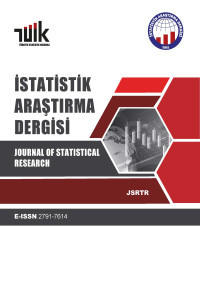Yangın Ekiplerinin Konumlarının Yöneylem Araştırması ve Coğrafi Bilgi Sistemleri Kullanılarak Belirlenmesi: İzmir Örneği
Orman yönetimi, Coğrafi bilgi sistemleri, Konumsal küme kapsama problemi, Konumsal bilgi sistemleri
Determination of Fire Crews Locations Using Operations Research and Geographical Information Systems: İzmir Case
Forest management, Geographical information systems, Location set covering problem, Spatial information systems,
___
- Aronoff, S., 1995. Geographic information systems: A management perspective. WDL Publications, Ottawa.
- Birkin, M., Clarke, G., Clarke, M., Wilson A., 1996. Intelligent GIS. John Wiley and Sons, Newyork.
- Church, R. L., 2002. Geographical information systems and location science. Computers and Operations Research, 29, 541–562.
- Church, R. L., Gerrard R. A., 2003. The Multi-level location set covering model. Geographical Analysis, 35, 278-289.
- DeMers, M., 1997. Fundamentals of geographic information systems. John Wiley and Sons, New York.
- Dimopoulou, M., Giannikos, I., 2004. Towards an integrated framework for forest fire control. European Journal of Operational Research, 152, 476-486.
- Estochen, B. M., Strauss, T. R., Souleyrette, R. R., 1988. An assessment of emergency vehicle response predeployment using GIS identification of high-accident density locations. Proceedings of the Crossroads – 2000, Ames, La., 221-226.
- Franklin, S. E., 2001. Remote sensing for sustainable forest management. CRC Press LLC., USA.
- Gilfoyle, I., Thorpe, P., 2004. Geographic information management in local government. CRC Press LLC., Boca Raton.
- Heywood, I., Cornelius, S., Carver, S., 2002. An introduction to geographical informations systems (2nd edition). Prentice Hall, Inc., United Kingdom.
- Hogg, J., 1968. The siting of fire stations. Operations Research Quarterly, 19, 275-287.
- Kazana, V., Fawcett, R. H., Mutch, W. E. S., 2003. A dec sion support modelling framework for multiple use forest management: The Queen Elizabeth forest case study in Scotland. European Journal of Operations Research, 148 (1), 102-115.
- Laurini, R., Thompson, D., 1992. Fundamentals of spatial information systems. Academic Press, San Diego.
- Lo, C. P., Yeung, A.K.W., 2002. Concepts and techniques of geographic information systems. Prentice Hall, Inc., New Jersey.
- Martell, D. L., Gunn, E. A., Weintraub, A., 1998. Forest management challenges for operational researchers. European Journal of Operational Research, 104, 1-17.
- Miller, H. J., 1996. GIS and geometric representation in facility location problems. International Journal of Geographical Information Systems, 10, 791–816.
- Mohren, G. M .J., 2003. Large-scale scenario analysis in forest ecology and forest management. Forest Policy and Economics, 5 (2), 101-206.
- O’Sullivan, D., Unwin, D. J., 2003. Geographic information analysis. Wiley and Sons, New York.
- Plane, D. R., Hendrick, T. E., 1977. Mathematical programming and location of fire companies for the Denver fire department. Operations Research, 25, 563-578.
- Potter, W. D., Liu, S., Deng, X., Rauscher, H. M., 2000. Using DCOM to support interoperability in forest ecosystem management decision support systems. Computers and Electronics in Agriculture, 27, 335-354.
- ReVelle, C., 1989. Review, extension and prediction in emergency service siting models. European Journal of Operational Research, 40, 58-65.
- ReVelle, C., Schweitzer, J., Snyder, S., 1996. The maximal conditional covering problem. INFOR, 34, 77-91.
- Shamsi, U. M., 2005. GIS applications for water, wastewater, and stormwater systems. CRC Press, Boca Raton.
- Toregas, C., Swain, R., ReVelle, C., Bergman, L., 1971. The location of emergency service facilities. Operations Research, 19, 1363-1373.
- Toregas, C., ReVelle, C., 1973. Binary logic solutions to a class of location problems. Geographical Analysis, 5, 145-155.
- ISSN: 1303-6319
- Başlangıç: 2002
- Yayıncı: TÜİK
Tekrar Satılabilir Ürünler için Gazeteci Çocuk Probleminin Çelişen Amaçlar Altında İncelenmesi
Umay UZUNOĞLU KOÇER, Mutlu KARA
Biyokimyasal Reaksiyonlar için Stokastik Simülasyon Algoritmalarına Genel Bir Bakış
Kümeleme Çözümlemesinde Düzeltilmiş Tek Adım M-Tahmin Edicisinin Kullanılması
Abdullah Fırat ÖZDEMİR, Engin YILDIZTEPE
Kapsamlı Bir İçerikle Ön Dağılım Türleri
Malmquist Endeksi ile 25 Ülkenin Ortaöğretim Performansının Değerlendirilmesi
Tek Değişkenli Zaman Serilerinde Model Seçim Ölçütleri Üzerine Bir İnceleme
Değişim Katsayılarının Eşitliğine İlişkin Testlerin I.Tip Hata ve Güç Bakımından Karşılaştırılması
Türk Reel Sektörü için Karşılaştırmalı Etkinlik Ölçümü: Veri Zarflama Analizi Uygulaması
